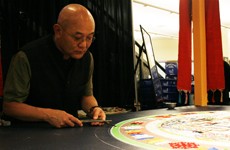When an artist finally completes his masterpiece, he or she is likely to step back and admire the art, knowing that their work will be appreciated for centuries to come.
When Losang Samten places the last grain of sand on his mandala next week he will step back, admire his work – and allow it to be destroyed.
Samten has set up shop on the bottom floor of the UofA Bookstore for the past month, working Tuesday through Saturday on “”The Wheel of Time”” mandala – an intricate design comprised entirely of colored sand. By the completion date on Sunday, Samten will have spent hundreds of hours bent over a table, painstakingly funneling colored sands into incredibly precise designs.
A faint tsk tsk tsk echoes from the bottom of the Bookstore; the only sound coming from Samten’s chakpos – the sole tool that aids him in creating his art. Like some kind of Pied Piper, the scratching of the chakpos lure shoppers midway down the stair case, pausing to lean and watch over the railing. Their eyes widen, their voices silent save for whispers of astonishment.
Decades earlier, as a student in a Tibetan Monastery, Samten felt the same sense of awe.
“”The first time I saw this in my life, I was mesmerized. I saw people coming every day and looking at it. I understand their feeling. I can see in their eyes. I had those thoughts the first time,”” he said.
Samten learned the techniques of creating sand mandalas from his teachers at the monastery, studying and memorizing the placement and patterns of the colors in the “”Wheel of Time”” design.
“”This is the most important mandala in our tradition, because the design has so much color, so much detail. And not only takes a long time to create, but it is involved in a lot of concentration and a lot of prayers,”” he said while funneling a hair-thin line of crimson sand onto an outer edge of the mandala.
Samten came to the UA last year in partnership with the Arizona Friends of Tibet. When they asked him to return and create a mandala on campus, he happily obliged.
“”I thought this would be a wonderful idea. Since last year, there has been so much going on in our country, here and everywhere. So I wanted to go to a place to promote peace. It has tremendous meaning. A lot of the design means something. A lot of positive messages,”” he said, explaining how the various colors and designs of the mandala represent elements of speech, mind, wisdom and compassion.
However, come March 15, these symbols will be swept away when the mandala is destroyed. Impossibly, Samten’s eyes seem to light up when he speaks of the destruction of all his efforts.
“”It is so wonderful. We create the design and people participate and join and sit together, with all the sand, and (say) a prayer. And then there is the sand and the energy and each person gets sand if they want to. We bless the home, university, mountains and lake,”” he said, describing the ceremony that the monks prefer to call “”dismantling.””
“”We are not just destroying it – it’s a blessing, giving back something good.””









